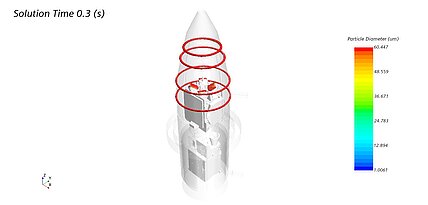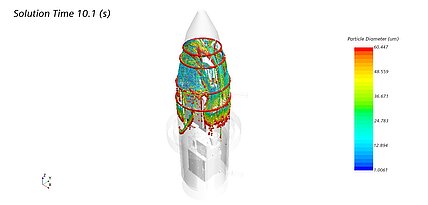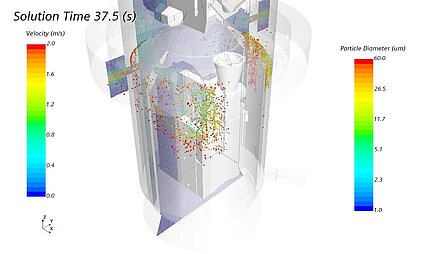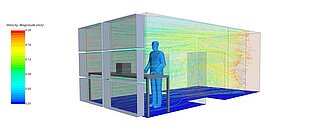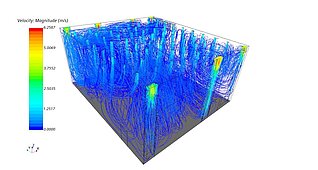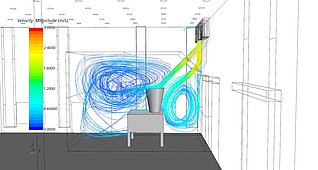Aerospace
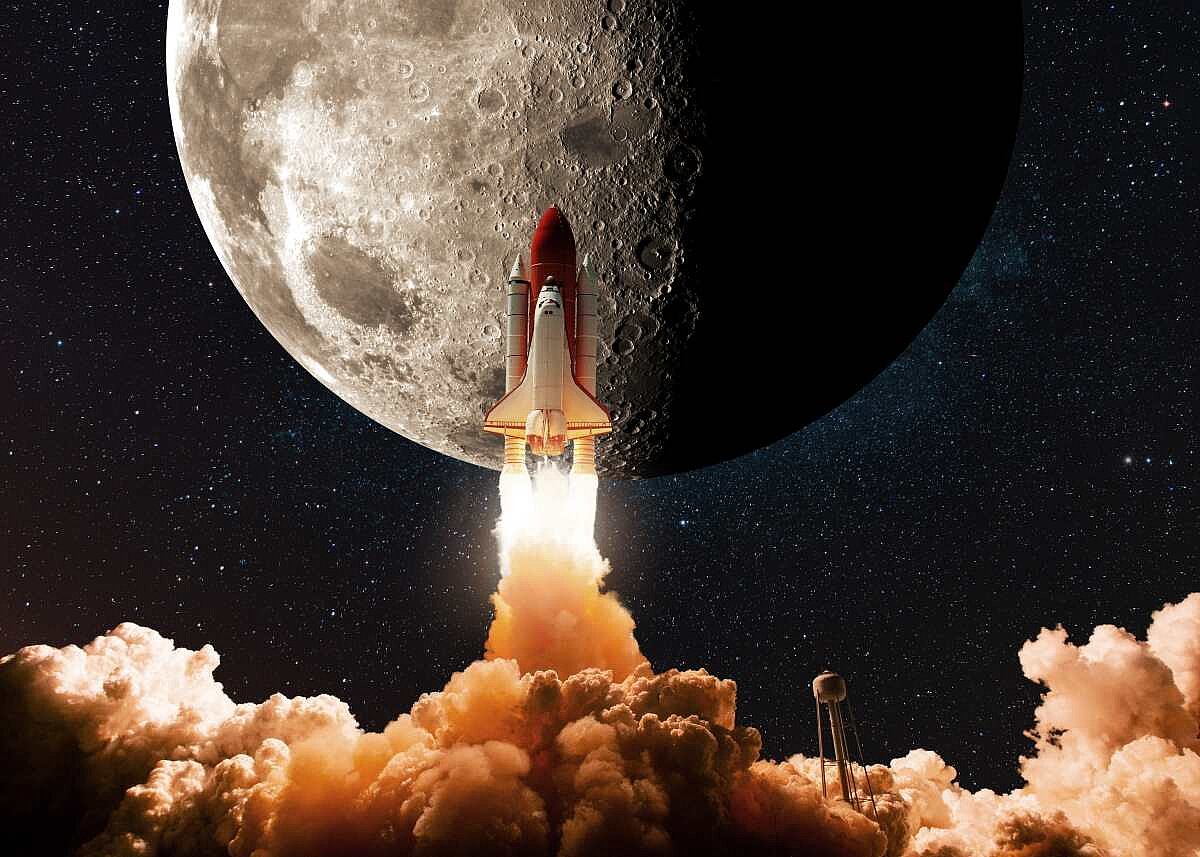
Introduction
For many years, the automotive sector at Merkle CAE Solutions was the technology driver for complex simulations. Here, we learned how to deal with complex physics in complex models and continuously developed new methods to expand the application area of simulation more and more. Due to the reorientation of the automotive industry towards electric mobility, this trend has somewhat come to a standstill.
In its search for new, up-and-coming business areas, Merkle CAE Solutions has increasingly established itself in the field of space travel in recent years and has established a strategic partnership here together with OHB System AG. We are also increasingly doing business directly with ESA, with a project currently underway under ESA Spark Funding.
Below are some of the current projects in the space segment which we have carried out and are carrying out together with OHB System AG in recent years.
Purging
To reduce the risk of contamination for critical satellite components during storage or integration, they are flushed with pure gases (air, nitrogen). The directional flow prevents the risk of particles accumulating on critical surfaces. Simulation can be used to determine the effectiveness of the air flow, the identification and evaluation of possible dead water areas, i.e. areas that are not flowed through, as well as the design (flow rate) of the gas flow used and the position and size of possible inlet and outlet openings.
Hot Purging
In space, the vacuum causes outgassing and separation of volatile components from non-metallic materials (e.g. cables, plastic covers, paints). Water is also critical in various applications. Accumulation or condensation of molecules or particles on thermally active or optical surfaces (lenses or mirrors), can reduce performance or compromise the mission objective. To reduce the risk of occurrence as much as possible, the process known as hot purging reduces or removes these types of contamination by elevating the temperature of the nitrogen-based purge stream before the components are deployed in space.
The concentration of evaporative emission is shown in color in the following images of a detailed model.
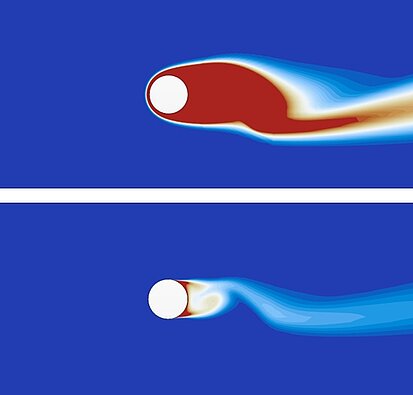
The goal of the simulation is to evaluate whether all potentially outgassing components are uniformly captured by the gas stream and whether emissions are being directed away from the component.
Coral
Contamination Risk at Launch
The launch campaign poses a significant risk in terms of contamination and the associated loss of performance, as the options for protecting the satellites during this phase are very limited. Sources of contamination are the air used for cooling, the fairing, and any satellites flying along for other missions.
During the launch phase, particles can spread throughout the fairing via vibrations and contaminate the satellites in an uncontrolled manner.
We make these effects visible via particle simulations on very detailed models of participating satellites and can thus make statements about possible deposition of particles on the satellite in order to estimate possible contamination risks. Particles with a size of up to 5 µm can be simulated.
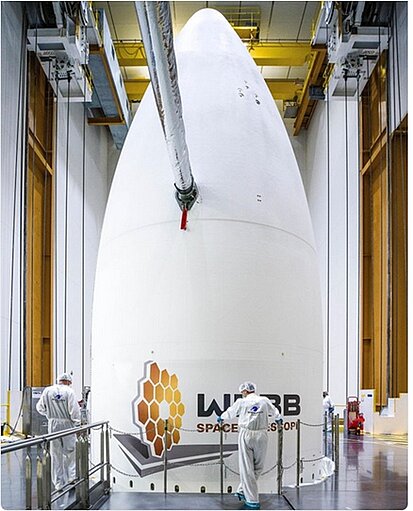
Particle simulations in connection with flow are among our most complex simulations today. In extreme cases, up to 30 million particles can be considered, but typical tasks are rather in the million range.
Clean chambers and clean rooms
The assembly of satellite components and satellites takes place in clean rooms of various classes, ISO 8 and better.
For this purpose, Merkle CAE Solutions has carried out extensive investigations. From a simple workstation, with a filter wall and horizontal airflow, to individual halls or even hall complexes (integration halls) divided into different zones. Here, the flow conditions around the satellites can also be considered.
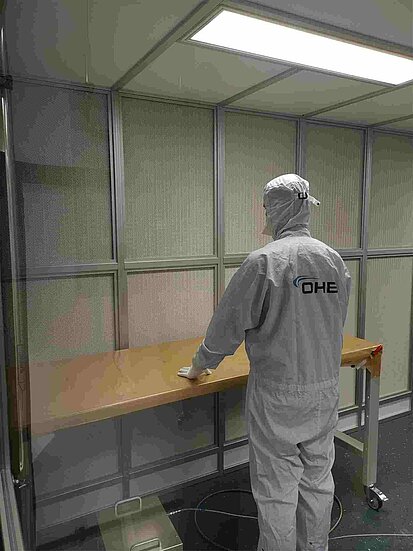
The advantage of the simulation is that statements about the behavior of the cleanroom can already be made during the planning of the building and the optimal positions of FFU's (Fan Filter Units) can be determined.
T-RE-X
Further exciting issues are current research topics with OHB on the subject of lunar dust. Lunar dust, known as regolith, is very sharp-edged. This is the result of billions of years of micrometeorite impacts on the atmosphereless moon.
On Earth, sand is abraded by the wind over time. This, however, is not present on the Moon.
The abrasiveness creates major challenges for lunar landings, as lunar dust is extremely harmful to the lungs. In addition, seals in space suits and airlocks are damaged by regulith. Optical problems occur when helmet visors or camera lenses become clogged. This is exacerbated by the electrical charge of the lunar dust. Likewise, the whirling up of lunar dust is of high interest when landing or launching rockets. If two lunar vehicles encounter each other, mutual interference also occurs.
In the joint research project T-RE-X, our primary goal is to describe the behavior of lunar dust under vacuum conditions and low gravity and to reconcile this with experimental results.
For this purpose we use the software Paladin from the Fraunhofer IST and Molflow from CERN, among others.
More information on the subject of lunar dust can also be found in our blog article "Lunar dust - killer criterion for longer lunar missions?"
Networking
As part of the joint collaboration between Merkle CAE and OHB in networks such as Space2Health (space/medicine) and Space2Motion (space/automobility), one topic is how space technologies can be used in other industries or how technologies from these industries can be usefully applied in space.
A prime example of this is cleanliness engineering approaches from spaceflight in building satellites during pandemics (such as Corona) for classrooms to use to contain the spread of the pathogen. This resulted in further approaches to measure, simulate and optimize the ventilation behavior of operating rooms in hospitals with regard to the spread of hospital germs. Other tasks from the field of medicine, e.g. the generation of hibernation via stimulation with ultrasound, are in turn of interest for space travel in Mars missions.
Summary and outlook
Human spaceflight and interstellar missions are no longer conceivable without the use of modern and non-dusty methods in the field of simulation. If one thinks, for example, of the construction of a manned station on the moon, new topics come up, such as the swirling of lunar dust during launch or the landing of landing vehicles. We have the appropriate tools, the necessary computing power and, above all, the experience in describing and simulating physical processes.
This is what drives us and what we burn for.
Benefit
The space sector has great potential to make greater use of the modern possibilities offered by simulation. Through our years of expertise, we can be instrumental in reducing costs and gaining additional insight through simulation. The benefit of simulation is to show things that are otherwise invisible and to simulate scenarios that are difficult to test on the ground.
Simulation is also a matter of confidence, namely that the simulation can describe real-world conditions with sufficient accuracy. This confidence can often be worked out together by comparing simulation and experimental results, even at a reduced scale.
If there is mutual understanding and one speaks the language of the business partner, processes that were previously very expensive and time-consuming can be made much more efficient.
Norms and standards
- ISO/TC 209
- ECSS-Q-ST-70-01C
- DIN EN ISO 14644
- a. v. a.
Keywords
- CORAL
- ESA
- Hot Purging
- Contamination
- Cross contamination
- Launch
- OHB System AG
- Optics
- Particles
- Purging
- Space travel
- Clean room
- Clean room
- Satellite
- Mirror
History
We already carried out our first projects in the aerospace sector at the beginning of the 1990s for AEG, later Thales, Tesat and Kayser Threde, which was later taken over by OHB System AG. Topics in the past were thermal management, shock and vibration behavior of electronic components, amplifier tubes, printed circuit boards and printed circuit board housings. Later, tasks from the military field of optical instruments were added. Lightweight construction and component optimization, but also damage analyses were often in the foreground when, for example, soldered joints in satellites became loose over time due to thermal expansion.
Today, the focus is more on fluidic tasks, which we solve with the help of various flow codes in the field of CFD.
